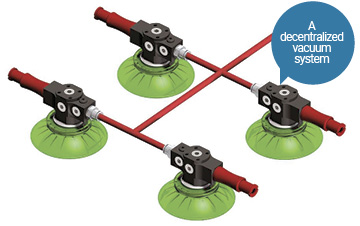Designing a Reliable and Efficient Vacuum System
By Mike Tuohey, Sales & Marketing Communications Manager, Piab USA Inc.
A vacuum system is made up of more than a pump, and its design is dependent on the application. However, all applications need reliable and efficient designs, so to illustrate how to achieve that, we will focus on two types of applications and systems.
Applications for vacuum pumps can be either nonporous or porous. Nonporous applications use sealed systems with a minimal amount of air passing through them. Such systems are usually easier to design than non-sealed, porous systems. One example of an application for a nonporous system is the evacuation of a reservoir or vacuum tank.
Sealed systems are simple
The design of a non-porous system hinges on three main considerations: the volume that is to be evacuated; the desired level of vacuum in the tank, and the time it takes to evacuate the tank. The first design step is therefore to calculate the total volume, which includes not only the space within the vacuum tank, but also all the connections and filters.
Next, the required vacuum level is set, and then the evacuation speed. The flow rating of a vacuum pump, usually measured in normal liters per minute (Nlpm) or standard cubic feet per minute (scfm), will help to determine the evacuation speed. The more free air a pump moves, the faster the evacuation time. The volume in the system and the vacuum level are factors determining a pump’s flow rate, with larger volumes and deeper vacuum levels taking longer to evacuate.
Porous systems are trickier
 Applications that require a porous vacuum system, such as the handling and lifting of corrugated cardboard boxes, rely on more elaborate designs. In a porous system, atmospheric air passes through objects at the vacuum point, and the important factor is the amount of vacuum flow (Nlpm or scfm) a pump can generate, as this has to compensate for the leaked air to sustain a given vacuum level.
Applications that require a porous vacuum system, such as the handling and lifting of corrugated cardboard boxes, rely on more elaborate designs. In a porous system, atmospheric air passes through objects at the vacuum point, and the important factor is the amount of vacuum flow (Nlpm or scfm) a pump can generate, as this has to compensate for the leaked air to sustain a given vacuum level.
The energy consumption of a porous system increases asymptotically with the vacuum level. This means that a doubling of the vacuum level might require as much as ten times the amount of energy. Therefore, vacuum levels usually need to be kept at a minimum.
In many lifting and handling systems this can be accomplished with a larger diameter suction cup because larger lifting areas will increase the lifting capacity and reduce the required vacuum pressure.
Reduce the volume and save energy
Another way in which energy can be saved is to reduce the volume in the vacuum system. The inside diameter of the vacuum hose obviously matters, as an unnecessarily large hose will add extra volume, slowing down the evacuation. However, if the hose is too small, the flow is restricted and the pump must work harder. A good rule of thumb is to choose a hose size that matches the pump’s vacuum port.
The volume that needs to be evacuated can also be reduced effectively by placing the pump closer to the vacuum point. In addition to cutting energy costs, this also shortens the system’s response time.
This is why a decentralized vacuum system with several smaller pumps close to where the vacuum is needed is preferable to a centralized system using one centrally placed pump. In a centralized system, there will be great losses due to the long hoses, bends, fittings, valves and filters, and these losses have to be compensated for by using a larger vacuum pump.
Decentralized systems are more efficient
 The energy consumption can be greatly reduced, often halved, if a centralized system is replaced by a decentralized system. Vacuum systems are different from compressed air systems, which are far less sensitive to losses. Hence, just as high voltage is used for long distance transport of electricity and then converted to low voltage as late as possible to minimize losses, compressed air should be converted to vacuum flow as late as possible in the system.
The energy consumption can be greatly reduced, often halved, if a centralized system is replaced by a decentralized system. Vacuum systems are different from compressed air systems, which are far less sensitive to losses. Hence, just as high voltage is used for long distance transport of electricity and then converted to low voltage as late as possible to minimize losses, compressed air should be converted to vacuum flow as late as possible in the system.
Another disadvantage of a centralized system is that, if the pump fails, the entire operation is down until repairs are made. Because there is only one pump, the maintenance is relatively easy. A decentralized system often requires synchronized operation, which potentially involves more maintenance. However, because the components of decentralized systems operate independently, faulty pumps can be serviced while the rest continue to run undisturbed.
In a centralized system, if the pump fails, the entire operation is down until repairs are made. In a decentralized system, faulty pumps can be serviced while the rest continue to run undisturbed because the components of decentralized systems operate independently.
Control devices can also help
The system can also be fitted with various energy-saving devices, including signaling controls. Such controls improve the efficiency by either signaling a certain vacuum level or by turning off a pump. Vacuum switches are common control devices that send either electric or pneumatic signals.
In a typical nonporous system, the vacuum switch is set to a certain vacuum level. When the pump reaches that level, the switch sends a signal to a solenoid valve that turns off an air-operated vacuum pump equipped with a non-return or check valve. The vacuum pump then holds the desired vacuum level with no further energy expended.
Filters keep it clean
Industrial environments are often dusty, and although all vacuum systems and pumps are affected by dust, in some applications contamination issues are of particular concern. Various vacuum filters can be placed between the pump and the vacuum point. Different types of filters include units with clear plastic bowls in which the particulate build-up can be monitored, or filters with metal housings for extra durability. Vacuum filters help prevent pump repairs and shorten downtime.
Do you want to learn more about vacuum system design?
To learn more about vacuum system design and Piab’s vacuum solutions for a diverse range of applications, visit www.piab.com. Piab is a worldwide organization with subsidiaries and distributors in almost 70 countries. Its headquarters are in Sweden.







